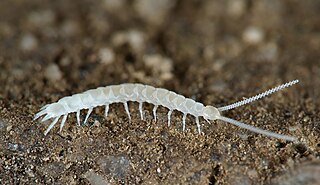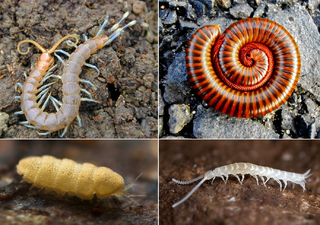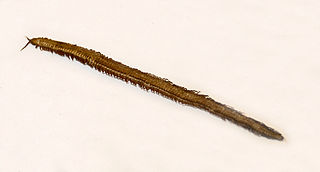Related Research Articles

Centipedes are predatory arthropods belonging to the class Chilopoda of the subphylum Myriapoda, an arthropod group which includes millipedes and other multi-legged animals. Centipedes are elongated segmented (metameric) creatures with one pair of legs per body segment. All centipedes are venomous and can inflict painful stings, injecting their venom through pincer-like appendages known as forcipules or toxicognaths, which are actually modified legs instead of fangs. Despite the name, no centipede has exactly 100 pairs of legs; number of legs ranges from 15 pairs to 191 pairs, always an odd number.

Pauropoda is a class of small, pale, millipede-like arthropods in the subphylum Myriapoda. More than 900 species in twelve families are found worldwide, living in soil and leaf mold. Pauropods look like centipedes or millipedes and may be a sister group of the latter, but a close relationship with Symphyla has also been posited. The name Pauropoda derives from the Greek pauros and pous or podus, because most species in this class have only nine pairs of legs as adults, a smaller number than those found among adults in any other class of myriapods.

Symphylans, also known as garden centipedes or pseudocentipedes, are soil-dwelling arthropods of the class Symphyla in the subphylum Myriapoda. Symphylans resemble centipedes, but are very small, non-venomous, and only distantly related to both centipedes and millipedes. More than 200 species are known worldwide.

Myriapods are the members of subphylum Myriapoda, containing arthropods such as millipedes and centipedes. The group contains about 13,000 species, all of them terrestrial.

The Cephalocarida are a class in the subphylum Crustacea comprising only 12 species. Both the nauplii and the adults are benthic. They were discovered in 1955 by Howard L. Sanders, and are commonly referred to as horseshoe shrimp. They have been grouped together with the Remipedia in the Xenocarida. Although a second family, Lightiellidae, is sometimes used, all cephalocaridans are generally considered to belong in just one family: Hutchinsoniellidae. Fossil records of cephalocaridans has been found in 462 million year old deposits.

Pauropodidae is the most diverse family of pauropods, containing 27 genera and more than 800 species, as well as the only known fossil pauropod, Eopauropus. This family has a subcosmopolitan distribution. Pauropods in this family are generally whitish and feature a sternal antennal branch with one seta and one globulus, setae on the head and tergites that are usually tapering or cylindrical, and a single anal plate. Like most adult pauropods in the order Tetramerocerata, most adults in this family have 9 pairs of legs, but adults in one genus, Cauvetauropus, have only 8 pairs of legs, and female adults in another genus, Decapauropus, have either 9 or 10 pairs of legs. The first species found to include pauropods with more than 9 pairs of legs was D. cuenoti, first described with 10 pairs in 1931.

The Agromyzidae are a family of flies, commonly referred to as the leaf-miner flies for the feeding habits of their larvae, most of which are leaf miners on various plants. It includes roughly 2,500 species, they are small, some with wing length of 1 mm. The maximum size is 6.5 mm. Most species are in the range of 2 to 3 mm.

Triops longicaudatus is a freshwater crustacean of the order Notostraca, resembling a miniature horseshoe crab. It is characterized by an elongated, segmented body, a flattened shield-like brownish carapace covering two thirds of the thorax, and two long filaments on the abdomen. The genus name Triops comes from Greek ὤψ or ṓps, meaning "eye" prefixed with Latin tri-, "three", in reference to its three eyes. Longicaudatus is an Latin neologism combining longus ("long") and caudatus ("tailed"), referring to its long tail structures. Triops longicaudatus is found in fresh water ponds and pools, often in places where few higher forms of life can exist.

Glomerida is an order of pill-millipedes found primarily in the Northern Hemisphere. Also known as northern pill millipedes, they superficially resemble pill-bugs or woodlice, and can enroll into a protective ball. They have twelve body segments, 17 to 19 pairs of legs, and males have enlarged rear legs involved in mating. The order includes about 30 genera and at least 280 species, including Glomeris marginata, the common European pill-millipede. The order contains members in Europe, South-east Asia and the Americas from California to Guatemala. Although historically considered closely related with the similar sphaerotheriidans that also enroll, some DNA evidence suggest they may be more closely related to glomeridesmidans, a poorly known order that does not enroll.

Chordeumatida is a large order of millipedes containing some 1200 species with a nearly worldwide distribution. Also known as sausage millipedes, they grow and develop through a series of moults, adding segments until they reach a fixed number in the adult stage, which is usually the same for a given sex in a given species, at which point the moulting and the addition of segments and legs stop. This mode of development, known as teloanamorphosis, distinguishes this order from most other orders of millipedes, which usually continue to moult as adults, developing through either euanamorphosis or hemianamorphosis.

Oryidae is a monophyletic family of soil centipedes belonging to the superfamily Himantarioidea.
Tetramerocerata is an order of pauropods containing 11 families and more than 900 species. This order was created in 1950 to distinguish these pauropods from those in the newly discovered genus Millotauropus, which was found to have such distinctive features as to warrant placement in a separate order (Hexamerocerata) created to contain that genus. The order Tetramerocerata includes the vast majority of pauropod species, as there are only eight species in the order Hexamerocerata, which remains the only other order in the class Pauropoda.

Plutonium zwierleini, in the monotypic genus Plutonium, is one of the largest scolopendromorph centipedes in Europe, and one of the few potentially harmful to humans. Nevertheless, it has been rarely reported, only from the southern part of the Iberian and Italian peninsulas, Sardinia and Sicily.
Brachypauropodidae is a family of pauropods. Pauropods in this family feature an entire first tergite, but at least the next three tergites are each divided into four to six sclerites, and the pygidial sternum has two or three pairs of setae. Like most adult pauropods in the order Tetramerocerata, most adults in this family have 9 pairs of legs, but adults in a few species in two genera, Aletopauropus and Zygopauropus, have only 8 pairs of legs. This family has a nearly worldwide distribution and is found on all continents except South America and Antarctica.
Linotaeniidae are a monophyletic clade of soil centipedes in the family Geophilidae found mostly in the temperate regions of the Holarctic as well as the south Andes. Species in the clade Linotaeniidae are characterized by a body that usually tapers toward the anterior tip; mandibles with a single pectinate lamella; second maxillae with coxo-sternite usually undivided and claws without projections; forcipular segment short, with tergite remarkably wide, forcipules evidently tapering; coxal organs opening through distinct pores on the ventral surface of the coxo-pleura. The number of legs in this clade varies within as well as among species and ranges from as few as 31 pairs of legs to as many as 83 leg pairs. Compared to most families in the suborder Adesmata, this clade features a modest number of leg-bearing segments and limited variation in this number within each species.

Scolopendrellidae is a family of symphylans in the class Symphyla. There are about 9 genera and at least 100 described species in Scolopendrellidae.

Scutigerellidae is a family of pseudocentipedes in the class Symphyla. There are about 5 genera and at least 140 described species in Scutigerellidae.
Zelanophilidae is a family of centipedes belonging to the order Geophilomorpha and superfamily Geophiloidea. Centipedes in this family are found in the Australasian region.
Zygopauropus is a monotypic genus of pauropod in the family Brachypauropodidae. The only species in this genus is Zygopauropus hesperius, first described by J.W. MacSwain and U.N. Lanham of the University of California at Berkeley in 1948. This genus is notable as one of only four genera of pauropods in which adults have only eight pairs of legs rather than the nine leg pairs usually found in adults in the order Tetramerocerata. Before the discovery of Z. hesperius, adult pauropods were thought to have only nine or (rarely) ten pairs of legs.
Decapauropus is a large genus of pauropods in the family Pauropodidae that includes more than 300 species. This genus was originally described by Paul Remy in 1931 to contain the newly discovered type species Decapauropus cuenoti. As the name of this genus suggests, this genus is notable for including females with ten pairs of legs instead of the nine leg pairs usually found in adult pauropods in the order Tetramerocerata. Before the discovery of D. cuenoti, adult pauropods were thought to have invariably nine pairs of legs.
References
- 1 2 3 4 5 Scheller, Ulf (2008). "A reclassification of the Pauropoda (Myriapoda)". International Journal of Myriapodology. 1 (1): 1–38. doi: 10.1163/187525408X316730 .
- 1 2 3 4 5 6 7 8 Scheller, Ulf (2011). "Pauropoda". In Minelli, Alessandro (ed.). Treatise on Zoology - Anatomy, Taxonomy, Biology. The Myriapoda. Vol. 1. Brill. p. 498. ISBN 978-90-04-15611-1.
- ↑ "ITIS - Report: Millotauropus". www.itis.gov. Retrieved 2024-02-26.